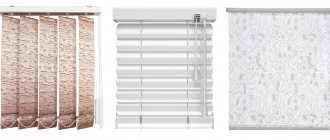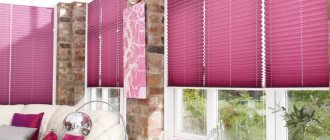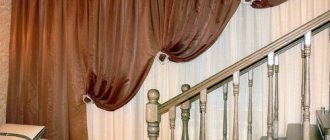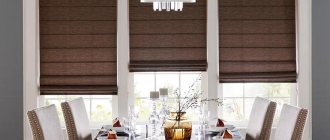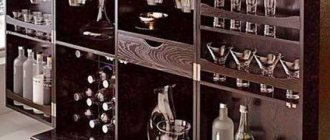13.05.2020
Blinds
How to choose blinds for windows? What to consider during the selection process? Do you need to focus on functionality or the ability to fit the structure into the surrounding space? And if the window has a non-standard opening... What to do in this case? Your questions will not go unanswered!
In this article you will learn:
- What are blinds and what are they made of?
- What is the difference between horizontal models and vertical ones?
- What are the pros and cons of the models?
- Which models fit perfectly into the interior of the rooms?
- How to combine blinds with other fabric decor elements
Choosing blinds is easy!
Blinds are a type of window decoration that is common throughout the world. Not only are blinds found in different countries, but also in completely different locations. Thus, roller blinds (curtains) are often used in dachas and balconies, vertical ones in medical institutions and government agencies, and horizontal ones are chosen for offices and apartments.
How to choose the right blinds for plastic or wooden windows is a question for a specialist, because the configuration of the product directly depends on the customer’s requirements and the characteristics of the facility.
Blinds blend into the surrounding space thanks to a range of materials
Blinds: types, sizes, materials
Blinds are an alternative to conventional fabric curtains. They effectively protect the room from prying eyes and bright sunlight. Previously, it was believed that such designs were a priority for office style, but modern models fit into the interior without problems.
To begin with, we suggest you understand the types of blinds:
- roll;
- vertical;
- horizontal;
- pleated.
Reviews about which blinds for plastic or wooden windows are best to choose can be easily found on the Internet. We suggest that you familiarize yourself with the pros and cons of the models in order to make the right choice.
Vertical blinds are suitable for windows with a beveled edge, and roller blinds (Mini model) are installed directly on the window sash - depending on the location and design wishes, customers choose a specific model
Roller blinds
The range of roller blinds allows you to integrate them into the interior of residential buildings, apartments, offices, hotels, shopping centers, restaurants and cafes. At the moment, this window design is an inexpensive and complete replacement for classic curtains. It is used in places where tulle or heavy curtains look out of place.
Roller blinds are the answer to the question: “which blinds to choose for the sunny side.” Thanks to the presence of Blackout material, the model protects the room from light. The fabric completely hides natural light, even from direct sunlight.
Blackout fabrics protect even from direct sunlight
The range of models of modern roller blinds includes:
- Standard blinds. They consist of a fabric sheet that is wound onto an open shaft. There is a guide bar at the bottom of the product.
- Mini. A compact version of blinds for home, office or cottage. The width of the shaft does not exceed 2 cm. Correct measurement is important for this product.
Installation of vertical blinds - step-by-step instructions
Wooden vertical blinds
Installing vertical blinds is not as difficult as it seems, although this work requires some skill.
Before assembling vertical blinds, you need to prepare all the necessary tools:
- Measuring level
- Pencil,
- Drill with hammer drill,
- Hammer,
- Screwdriver,
- sharpened knife,
- Slotted and Phillips screwdriver,
- A set of fasteners and drills of different diameters.
Ways to control vertical blinds
Vertical blinds for plastic windows can be assembled in three ways:
1) The control assembly is on the left, and the lamellas are on the right.
2) Assembling control and bars on the same side.
3) The control assembly is on the right or left, and the bars move from the center to the edges.
4) The control assembly is left or right, and the bars move from the edges to the center.
And the mounting of vertical blinds can also be done in three ways:
Methods for installing vertical blinds
1) To the ceiling.
2) To Wall.
3) To the window structure.
Now let's move on to the actual installation of vertical blinds. The instructions, if you follow all of its points, will allow you to correctly install vertical blinds with your own hands.
If you decide to install blinds with your own hands, then perhaps you will be interested in installing wooden euro windows yourself? The instructions on our website will help you solve this problem: “Installing wooden Euro-windows with your own hands - is it possible, but is it necessary...” For craftsmen with skilled hands, information on how to insulate a plastic window without the help of hired specialists will also be of interest. Instructions for insulating wooden windows is posted here: https://oknanagoda.com/okna/plastik/uteplenie/kak-uteplit-okna-k-zime.html
1. Using a measuring level, mark in advance the places where the cornice will be attached. This is necessary in order to hang the cornice of vertical blinds strictly horizontally and accurately.
Important! If you want to attach a cornice to a wall or ceiling, the blinds should extend beyond the level of the window opening by 5-10 cm.
Attaching the cornice
2. Secure the curtain rod with the latches as shown in Figure 2.
3. Hang the lamellas by the bar holders to the runners (see Figure 3) in the order in which they are located on the roll. This is especially important if the slats have an image.
4. Attach the connecting chain to the weights as shown in Figure 4.
Slat suspension
5. Straighten the vertical blinds so that the slats are parallel to each other.
6. Check the operation of the finished blinds. The slats should move freely along the cornice. After moving, be fixed in a vertical position.
How to install vertical blinds VIDEO instructions can be viewed here:
https://www.jalux.ru/video/video_ustanovka_vertical_jalyuzi.html
Chain attachment
In addition to assembly, it is also important to know how to properly adjust the light output. As noted earlier, the rotation of the slats is carried out thanks to the control chain. You can move, expand and assemble the slats (slats) by pulling the control rope. Under no circumstances should the slats be moved to the side when the blinds are fully closed.
And if we talk about caring for vertical window blinds, then you can only use dry cleaning! You can read more about this in the article on our website “Caring for vertical blinds.”
Horizontal, vertical, rolled or pleated: which models to choose
As you already understand, blinds of different models fit into the interior differently. Which type of blinds is right for you? It all depends on the configuration of the window, room and design features.
Horizontal blinds are made of aluminum and completely protect from light. Vertical ones can consist of fabric slats or canvas, which create cozy diffused lighting.
Blinds made of aluminum and plastic, as well as Blackout material, are completely lightproof
Horizontal blinds are easy to care for. A special brush is convenient for cleaning the slats from accumulated dirt and dust. But even without this product in your arsenal, you can easily clean the structure with a soft cloth.
Vertical blinds made of fabric require special care, especially considering that the fabric is impregnated with a special compound that repels dust and moisture. Fabric slats are best dry cleaned. Unfortunately, roller blinds and pleated blinds cannot be processed independently. Models made of aluminum or plastic can be easily cleaned with a damp cloth.
Horizontal blinds are preferred to be installed in office premises. Strict design, texture and geometry make them especially attractive. Vertical blinds are more decorative. They are preferred in government agencies, kindergartens, schools and institutes. Rolled and pleated are an option for a home or hotel, office; they automatically make the room cozy.
If you have a child in your home, then it is worth considering that horizontal blinds are quite easy to deform. They hold their shape well and are resistant to damage, but after mechanical impact on the slats, it is extremely difficult to insert them back. Vertical blinds get dirty easily, and their cord can be dangerous for small children.
What are blinds? Their features
In their original form, the products were made from wooden strips that were installed on windows. Modern blinds consist of structural elements driven by mechanical control using chains and laces.
The use of an electronic method involves the installation of an electric drive, with which you can adjust the intensity of lighting. This method is convenient for high window structures. Many people ask why indoor blinds are needed. The products provide heat retention and are a functional and stylish way to design.
Unlike fabric curtains, slats do not require regular washing, so they are often used in office spaces. Systems of this type are an excellent solution when installed in window openings of various configurations. The main purpose of blinds is to create twilight in the room.
Design features ensure ease of operation, and the use of a wide range of materials allows you to stylishly decorate the interior. Adjusting the position of the slats helps regulate the lighting. Products are made from high-quality materials and are treated with special solutions to increase their service life.
The question of what blinds are can be answered by designers who implement various solutions. The products are often used in modern home interiors, kitchens, and studios. The option of print and photo printing on canvas can add accents to the room.
Pros and cons of models
Each type of blinds has its own advantages and disadvantages, which become decisive in the matter of choice. Now we will tell you how to choose good blinds for windows.
Rolled
Advantages of roller blinds:
- large selection of fabrics;
- suitable for any interior;
- no difficulties in maintenance and repair;
- fixed at the required height;
- can be either opaque or transparent;
- look great paired with curtains;
- do not fade in the sun.
Disadvantages of roller blinds:
- the rotation mechanism may fail;
- the fabric absorbs odors and cannot be washed;
- When mounted on a window sash, ventilation problems may arise.
Roller blinds can be shipped to any location
Vertical
Advantages of vertical blinds:
- protect from direct sunlight;
- easy to use;
- look appropriate in different locations;
- bring a new touch to any interior;
- Piece-by-piece repair of blinds is possible;
- control of light entering the room by rotating the slats;
- similarity in the process of use with conventional curtains.
The principle of opening and closing vertical blinds is similar to classic curtains, which makes them understandable for the older generation
Disadvantages of vertical blinds:
- “Striped light” can make your eyes tired;
- take up part of the space in front of the window;
- when there is a draft they create noise.
Vertical blinds have a separate advantage: they can be installed on non-standard openings:
- 2 in 1 with a straight edge is suitable for window openings that are combined with a balcony door;
- 2 in 1 with a beveled edge is suitable for spaces where there is furniture near the window;
- with a beveled edge, suitable for windows in stairwells;
- with an inclined cornice are mounted, for example, on a roof slope.
Horizontal
Advantages of horizontal blinds:
- do not require special care, just wipe with a damp cloth;
- simple installation;
- the most economical;
- act as an addition to any interior;
- regulate the level of illumination in the room;
- take up little space;
- do not collect dust.
Disadvantages of horizontal blinds:
- “striped light” quickly tires the eyes;
- Do not install near open fire sources and stoves;
- some materials turn yellow from sunlight;
- deformed from mechanical influence.
Lightweight designs of horizontal blinds are almost invisible on the windows
Horizontal blinds are also installed on non-standard openings:
- Trapezoid. This shape has two beveled edges.
- Half-trapezoid. It has one beveled edge, suitable for use on flights of stairs.
- Circle for attic windows.
- Double width. It is possible to install blinds on super wide openings.
Pleated
Advantages of pleated blinds:
- washable;
- convenient for residents of the first floors in that it is possible to close the lower part of the window;
- installation on ceiling windows;
- choice of combination of materials;
- can be installed on any type of window;
- attached in various ways;
- There is a choice of control method.
When choosing a pleated model, you no longer need to think about how to decide on the type of blinds for your windows.
Flaws:
- Even the blackout material does not shade the room 100%.
Each model has its own disadvantages and advantages, so before choosing a particular product, it is better to consult a professional.
Material selection
Various types of blinds are made of metal, fabric, wood. Depending on the chosen material, each type of structure has advantages and disadvantages of installation and operation.
Aluminum
Products in which the panels are made of metal are installed on window and door openings of offices and cottages.
Aluminum plates can have different shades. The surface can be mirror-smooth or have a velvety texture. The play of light and shadow in the room allows you to create perforated slats.
Metal curtains are easy to care for. It is enough to wipe them once every 2-3 months with a damp sponge. The products are resistant to temperature changes. Thanks to the reflectivity of the material, the optimal temperature is maintained in the room.
Disadvantages of the material include its tendency to warp. When the windows are opened and the slats touch, a characteristic sound is heard.
Plastic
Products made from this material differ in color and texture. They are mainly used in medical institutions and laboratories. They are convenient and durable to use. It is not recommended to install structures of this type in residential premises and children's rooms.
The material perfectly combines low price, strength and versatility of use. Plastic is resistant to temperature, mechanical damage, and is easy to maintain.
The range of products of this type is represented by a variety of textures and shapes, which provides the opportunity to choose the appropriate option. When choosing, it is recommended to pay attention to the quality of the plastic, which will retain its integrity and color during use.
Textile
For the production of systems, materials of various textures are used. The range of fabrics is presented in a wide color spectrum. The canvas is easy to use and lightweight, which is why it is often used in interior decoration of office premises, kindergartens, and schools.
Wide blinds look elegant and visually increase the height of the room. The fabric design option allows you to create comfort and emphasize the advantages of the interior. Products can be in the form of individual strips or a single piece of fabric. The service life of the systems depends on the density of the fabric and the presence of additional processing that increases wear resistance.
New on the market are vertical rope systems. There is also a name for them “string”, which means thread. They consist of a set of ropes, look light, and provide the ability to combine elements of different shades. Rope blinds, like other types, can be moved to the side and rotated around its axis.
Tree
The use of natural materials in the manufacture of canvases expands the range of design solutions. The canvas can be made from bamboo blanks intertwined with silk thread.
The advantage of this type of design is the creation of a kind of grid. The sun's rays enter the room through small cracks in the texture of the material. At the same time, the slats completely hide the room from prying eyes.
Another natural material for blinds is wood. The slats for them are made from Canadian linden, pine, and cork. They are thin sticks intertwined with thread. The systems complement the interior, in which wood predominates. Advantageous characteristics include:
- environmental cleanliness;
- durability;
- strength;
- resistance to temperature changes;
- Possibility of use in the decor of any interior.
Wood products are highly expensive. The material cannot withstand high humidity, so dry cleaning is recommended. Wood is not painted, so the range of products is presented in beige and brown shades.
How to choose blinds depending on color
We already know how to choose blinds by material, type and installation methods, but color is no less important.
Classic blinds are white, and this color will match the interior in most cases. For more stylish options, you can build on the color of furniture and carpets by choosing curtains to match. Blinds that are several shades lighter or darker than the wall color, or contrasting with the main color in the room, will look beautiful. Light blinds will visually make the room larger, and bright ones will make a good accent if the main colors in the design are neutral.
How to choose blinds for different rooms
For small rooms, horizontal blinds are suitable, visually expanding the room, and if you need to visually increase the height, vertical blinds are suitable.
In the kitchen it is worth hanging practical aluminum and plastic models, or fabric ones (made of water-repellent and heat-resistant fiberglass).
Fabric blinds create maximum coziness, so they are suitable for a bedroom or living room. Their roll type would be practical.
Wooden blinds will complement a study or a room with a lot of wooden furniture, while metal blinds will complement a high-tech interior.
Practical plastic is suitable for balconies, bathtubs and bathrooms.
